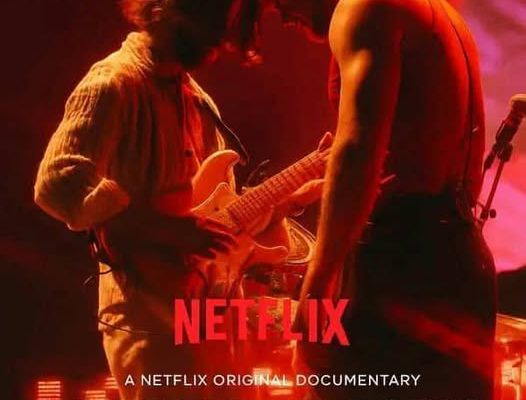When Netflix announced its latest music documentary, “Imagine Dragons”, fans around the world knew they were in for something extraordinary. The band that has defined a generation with anthemic hits like “Radioactive,” “Demons,” “Believer,” and “Thunder” finally gets the cinematic spotlight their story deserves. This isn’t just another music documentary — it’s a raw, emotional, and deeply inspiring chronicle of how four musicians from Las Vegas transformed their struggles, doubts, and dreams into a global movement. Netflix takes audiences deep inside the soul of Imagine Dragons — exploring the highs, the heartbreaks, and the human resilience behind their electrifying sound.
The documentary begins where every great story does — with humble beginnings. Viewers are taken back to Las Vegas in the late 2000s, when a young Dan Reynolds, burning with passion and uncertainty, was still trying to find his voice in the sprawling desert city. Through grainy early footage and intimate interviews, we see a band struggling to define themselves in a world that didn’t yet understand their vision. Dan Reynolds, guitarist Wayne Sermon, bassist Ben McKee, and drummer Daniel Platzman weren’t chasing fame; they were searching for something real — an emotional truth that could unite people through sound.
From their earliest gigs at small bars on the Las Vegas Strip to the moment “Radioactive” exploded across radio stations, the film captures the unpredictable rise of a group whose sound defied labels. Their fusion of alternative rock, electronic textures, and cinematic percussion became a new musical language — one that spoke to outsiders, dreamers, and believers alike. Netflix brilliantly juxtaposes concert footage with behind-the-scenes tension, revealing how the band’s signature sound wasn’t born out of ease, but through friction, experimentation, and the relentless pursuit of authenticity.
But “Imagine Dragons” doesn’t just tell a story of fame; it tells a story of survival. At the heart of the documentary lies the personal and emotional battles each member faced while navigating success. Dan Reynolds opens up about his struggles with depression, faith, and self-worth — topics he once kept buried beneath the surface of fame. His honesty is disarming, his vulnerability magnetic. In one poignant scene, he admits that music wasn’t just an outlet; it was his lifeline. The songs that fans found healing were often written from the darkest corners of his own pain.
Netflix captures the band’s evolution not only musically but emotionally. As the group transitions from the breakout success of Night Visions to the reflective tones of Smoke + Mirrors, and later the empowering energy of Evolve and Origins, viewers witness the growth of artists learning to balance personal identity with global recognition. Every album becomes a chapter — each one reflecting a different stage of the band’s self-discovery. There’s an unfiltered honesty in how the band members describe their creative process: the sleepless nights, the endless studio sessions, and the constant fear that the next album might not live up to the last.
The visual storytelling of the documentary is pure Netflix magic — cinematic, immersive, and emotionally charged. Sweeping drone shots of massive stadiums packed with roaring fans blend seamlessly with quiet moments of solitude — a tearful phone call home, a long stare at the tour bus window, a father holding his child before heading on stage. It’s this contrast between the extraordinary and the ordinary that defines Imagine Dragons. Behind the fireworks and flashing lights, there’s a profound humanity.
What makes the film stand out is its refusal to glamorize the rockstar lifestyle. Instead, it humanizes it. The audience sees the pressure, the exhaustion, and the toll fame takes on relationships and mental health. Reynolds’ commitment to using his platform for advocacy — particularly his work with the LOVELOUD Foundation supporting LGBTQ+ youth — becomes a central theme. Netflix doesn’t shy away from showing the criticism he faced, but it equally celebrates his courage to stand firm in his beliefs. His journey from conflicted churchgoer to outspoken ally is portrayed with grace and authenticity, reminding viewers that true leadership in music comes not just from talent, but from heart.
The band’s chemistry is another powerful thread woven throughout the documentary. There’s a brotherhood among Reynolds, Sermon, McKee, and Platzman that transcends fame. Through candid interviews, they recall arguments, creative disagreements, and even moments when they considered walking away. Yet what emerges is a testament to unity — a group of individuals bound not just by sound, but by shared struggle. When they play together, there’s an almost spiritual energy — a release that turns pain into purpose.
Netflix also explores how Imagine Dragons’ music became a global phenomenon. From Tokyo to Rio, from Berlin to Johannesburg, the documentary highlights the universality of their message. Their songs became anthems for the underdog, the misfit, the dreamer. Audiences from every culture found their own stories in lyrics like “Don’t you tell me what you think that I could be” and “I want to hide the truth, I want to shelter you.” It’s rare for a band to transcend language barriers and genre boundaries so effortlessly, yet Imagine Dragons managed to do just that. Their performances are less concerts and more collective healing sessions — moments where thousands of people connect through shared emotion.
Netflix also gives viewers an inside look at the band’s creative alchemy. We see Dan Reynolds scribbling lyrics in notebooks, experimenting with vocal tones, and searching for melodies that “feel” right more than they sound perfect. Wayne Sermon’s intricate guitar layers and McKee’s precision on bass reveal the meticulous craftsmanship behind the seemingly effortless soundscapes. Platzman’s drumming, thunderous yet nuanced, becomes the heartbeat of the band. Through all of it, the documentary captures that rare balance between chaos and clarity — the artistic tension that fuels greatness.
One of the most moving sections focuses on the band’s resilience in the face of personal tragedy and public pressure. Netflix documents Reynolds’ health challenges, the toll of relentless touring, and moments when he nearly gave up music altogether. But every time, the band found a way to rise — stronger, wiser, more united. The segment showing their return to the stage after a difficult hiatus is especially powerful. The roar of the crowd, the pounding drums, and Reynolds’ tear-filled eyes create a moment that feels almost sacred. It’s not just a comeback; it’s a resurrection.
The emotional climax of the film is a breathtaking montage — a fusion of past and present that shows just how far Imagine Dragons have come. Clips of the band’s first performances are mirrored against their massive stadium tours, reminding viewers that success isn’t defined by fame but by endurance. The closing minutes feature “Believer” performed live under a thunderstorm, as Reynolds belts out, “Pain! You made me a believer!” It’s cinematic poetry — a perfect symbol of the band’s journey from pain to empowerment.
Throughout its 150 minutes, Netflix’s “Imagine Dragons” doesn’t just tell the story of a band; it tells the story of humanity itself. The search for meaning, the battle with inner demons, the courage to be vulnerable, and the hope that art can heal — these are the universal truths that pulse through every frame. Viewers don’t just watch Imagine Dragons’ story unfold; they feel it. By the end, it’s impossible not to reflect on one’s own journey — the moments of doubt, resilience, and triumph that shape us all.
The documentary’s soundtrack, of course, is a masterpiece in itself. Iconic tracks are reimagined through stripped-down, acoustic versions that expose their emotional core. Hearing “Demons” sung softly over home video footage of the band’s early days hits differently — it’s intimate, vulnerable, and deeply human. Netflix’s sound engineers masterfully blend concert audio with studio sessions, giving fans an immersive listening experience that feels both grand and personal.
As the credits roll, one thing becomes clear: Imagine Dragons aren’t just musicians — they’re storytellers of the soul. They’ve turned their pain into anthems, their questions into community, and their flaws into fuel for greatness. Netflix’s portrayal captures this perfectly — not as a glossy highlight reel, but as a living, breathing portrait of four men who dared to be real in an industry often obsessed with perfection.
“Imagine Dragons” is more than a documentary; it’s a revelation. It reminds us that behind every hit song lies a heartbeat, behind every lyric a confession, and behind every concert a story of struggle and redemption. For fans, it’s a celebration. For newcomers, it’s an awakening. And for everyone watching, it’s a reminder that the power of music isn’t just to entertain — it’s to heal, to unite, and to move the world.
Netflix once again proves its mastery in storytelling, turning the journey of Imagine Dragons into something far greater than a music film — it’s an anthem for resilience, self-discovery, and the universal need to believe in something bigger than ourselves. Whether you’ve been a fan since “Radioactive” or you’re hearing their story for the first time, this documentary will leave you inspired, emotional, and forever changed.
Because at its core, “Imagine Dragons” isn’t just about a band — it’s about all of us, learning to rise, to fall, and to find light in the darkness. Netflix doesn’t just show the music that moved the world — it shows the hearts that created it. And that is what makes this film unforgettable.



